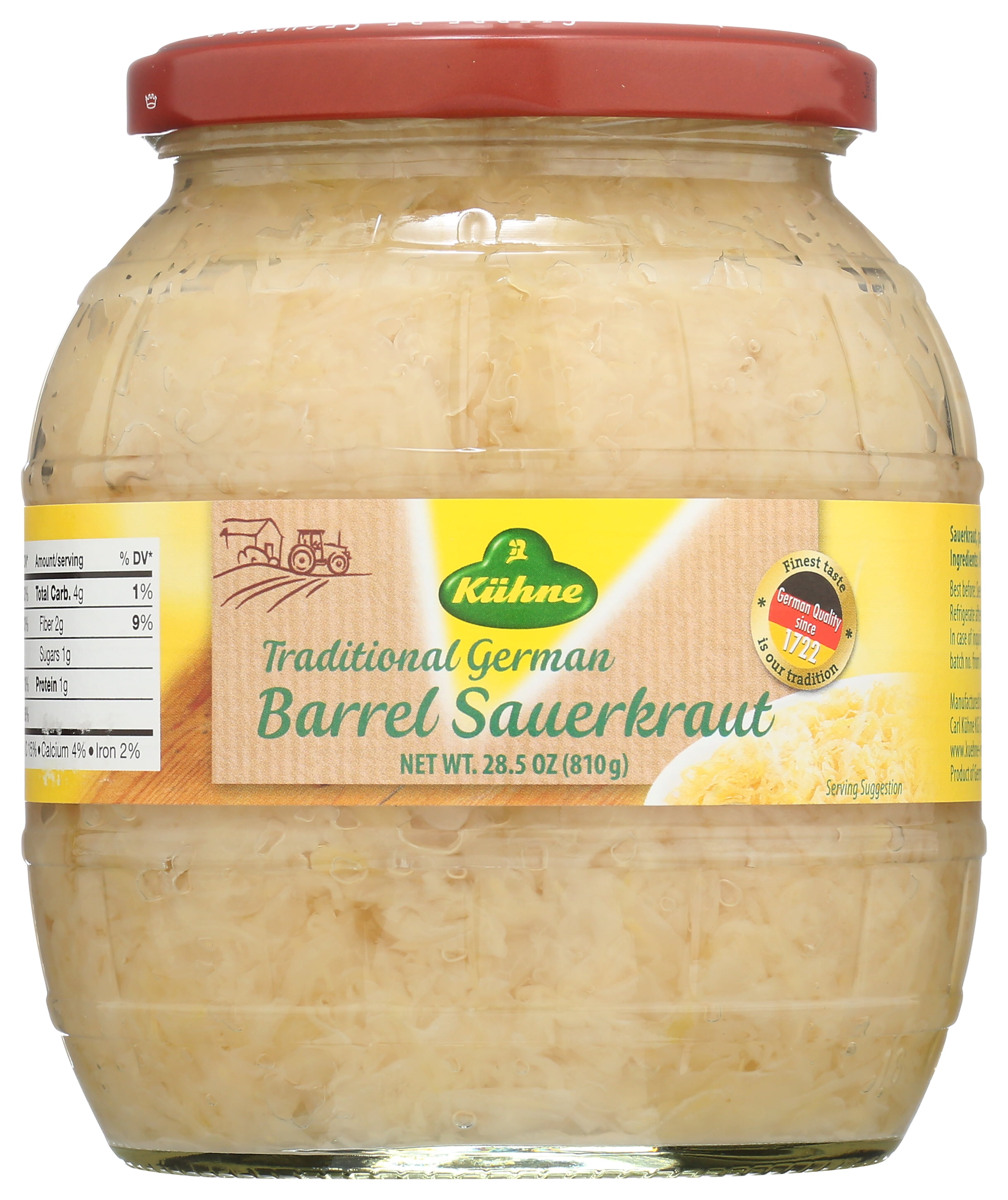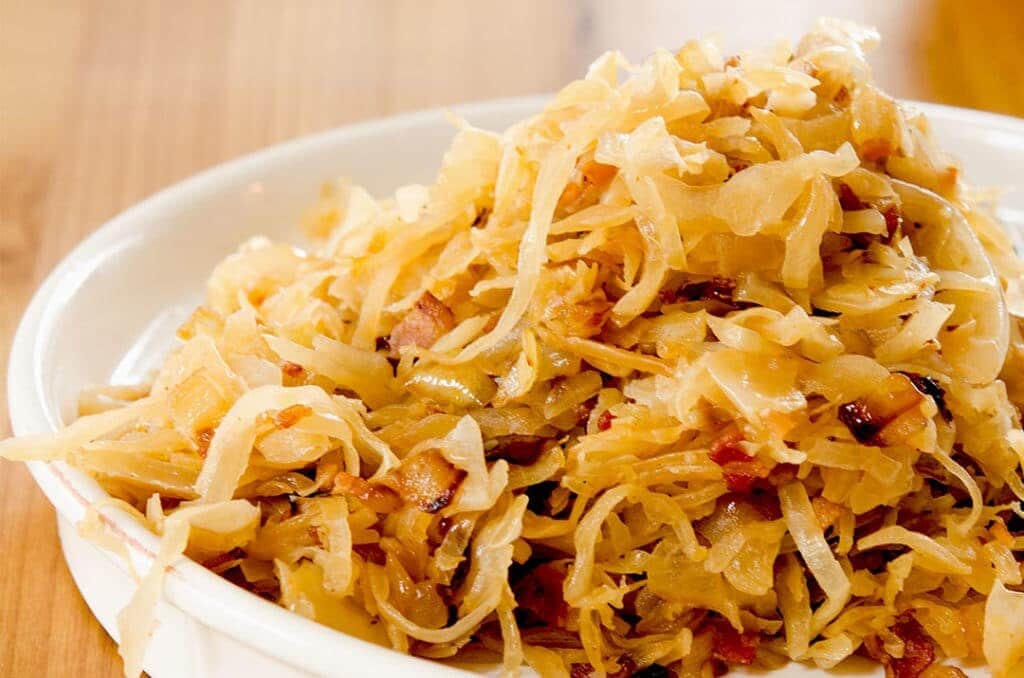How To Make Sauerkraut
by Admin
Posted on 11-10-2023 02:31 PM

Sauerkraut is often one of the first fermentation project s recommended to curious diy-ers, and with
good
reason: it’s beyond easy to make, requires very little special equipment, and the results are dependably delicious. All you need to do is combine shredded cabbage with some salt and pack it into a container. You can use a crock if you have one and want to make a lot of sauerkraut, but a mason jar will do just fine for small batches. The cabbage releases liquid, creating its own brining solution.
 Submerged in this liquid for a period of several days or weeks, the cabbage slowly ferments into the crunchy, sour condiment we know and love as sauerkraut.
Submerged in this liquid for a period of several days or weeks, the cabbage slowly ferments into the crunchy, sour condiment we know and love as sauerkraut.
Start with a head of cabbage. Before you do anything to it, weigh it. Write down the weight—you’ll need this to calculate how much salt to use later. Peel off the outer leaves of the cabbage. These tend to be dirty or damaged. You don’t want them in your sauerkraut! next, cut out the core of the cabbage. I like to give the cabbage a good rinse at this point. Since you cut out the core, the water can flow into the leaves and wash them. Make sure to turn the cabbage upside down and shake out any water. Peel off one more outer leaf and save it for later.
Sauerkraut ( /ˈsaʊ. Ərˌkraʊt/ ; german: [ˈzaʊ. Ɐˌkʁaʊt] ⓘ , lit. 'sour cabbage') is finely cut raw cabbage that has been fermented by various lactic acid bacteria. It has a long shelf life and a distinctive sour flavor, both of which result from the lactic acid formed when the bacteria ferment the sugars in the cabbage leaves. Although it is considered a national dish in germany and is known under its german name in english-speaking countries, it did not originate in germany and is also a traditional and ubiquitous dish in central and eastern europe. Overview and history[ edit ].
A comprehensive, step-by-step pictured tutorial on how to make sauerkraut that is incredibly healthy and delicious! making your own fermented homemade sauerkraut is super easy, requires minimal prep work, and the rest is just a waiting game! sauerkraut is in my blood. Being from germany and raised by a health-conscious mom, i ate this stuff on a regular basis. In germany sauerkraut is eaten fresh or cooked in a wide variety of dishes; everything from casseroles and soups to salads or alongside meats and sausages. Raw fermented sauerkraut was always readily available in our local health food stores. My mom and i regularly went to our local reformhaus and in the refrigerated section was a large vat of fresh sauerkraut where we could scoop out as little or as much as we wanted into the bags provided.
How to make sauerkraut
เซาเออร์เคราท์ใน โปแลนด์ (kiszona kapusta)
ชื่ออื่น
เครื่องปรุงรส
แหล่งกำเนิด
เยอรมัน
ภูมิภาค
ยุโรป
ส่วนผสมหลัก
กะหล่ำปลีหั่นดองจนมีรสเปรี้ยว
รูปแบบอื่น
มีอาหารที่คล้ายกันนี้ในเนเธอร์แลนด์ รัสเซีย และโปแลนด์
ชูครุตการ์นี อาหารฝรั่งเศสที่นำเซาเออร์เคราท์ไปปรุงกับไส้กรอกและผลิตภัณฑ์จากเนื้อหมูแบบอื่น ๆ
เซาเออร์เคราท์ ( เยอรมัน : sauerkraut,
ออกเสียง:
[ˈzaʊ. Ɐˌkʁaʊt]
) เป็น อาหารเยอรมัน ชนิดหนึ่ง แปลตรงตัวว่ากะหล่ำปลีเปรี้ยว เป็นการดอง กะหล่ำปลี โดย แบคทีเรียที่ผลิตกรดแลกติก หลายชนิด ได้แก่ leuconostoc , lactobacillus และ pediococcus เก็บได้นาน มีรสเปรี้ยว ใช้ปรุงอาหารได้หลายชนิด โดยเฉพาะกับเนื้อและ ฮอตดอก
เซาเออร์เคราท์ทำจากกะหล่ำปลีหั่นแล้วนำไปหมักกับเกลือ ใส่เม็ด ผักชี ใบเบย์ ผลเอลเดอร์ ยี่หร่า ฮอร์สแรดิช ใบเซโวรี กานพลู และเครื่องเทศอื่น ๆ ซึ่งแตกต่างกันในแต่ละท้องถิ่น นิยมรับประทานกับ ปลาเค็ม ไส้กรอก หรือหมูหมักเกลือ อาหารเยอรมันชนิดนี้ส่งอิทธิพลต่อ อาหารฝรั่งเศส ที่เรียก ชูครุตการ์นี ซึ่งเป็นกะหล่ำปลีดองเกลือเช่นกัน และยังพบอาหารที่ใกล้เคียงกันนี้ใน อาหารรัสเซีย และ อาหารโปแลนด์ ด้วย
กรรมวิธีการหมัก[ แก้ ]
ใส่ กะหล่ำปลี สดหั่นลงในหม้อ ทุบให้กะหล่ำช้ำจนกระทั่งน้ำภายในตัวกะหล่ำไหลออกมาจนท่วม เกลือที่ใส่ลงไปนี้จะทำให้คงสภาพจนกระทั่งเข้าสู่การหมัก ถ้าเป็น "ไวน์เซาเออร์เคราท์" ใส่ ไวน์ขาว ด้วยเล็กน้อย ใช้เกลือทะเลในการหมักโดยใช้เวลาประมาณ 4–6 สัปดาห์ กะหล่ำปลีถูกอัดและใช้น้ำหนักกดทับลงไป เดิมใช้หม้อดินเผาสำหรับการหมักเพื่อไล่อากาศออก ขณะเดียวกันก๊าซที่ได้ก็จะถูกกักเอาไว้ หม้อดินสำหรับทำกะหล่ำปลีดองมีร่องเพื่อให้น้ำไหลเวียน วางฝาปิดทับไว้ด้านบนให้แช่น้ำจนมิดเพื่อกันมิให้อากาศเข้า แรงกดจะช่วยดันให้ฟองอากาศออกมาภายนอก
กระบวนการหมักจะแบ่งออกเป็น 3 ขั้นตอนดังนี้
ช่วงสามวันแรก ยีสต์และแบคทีเรียแอซีติก (ซึ่งมีอยู่เดิม) ใช้ออกซิเจนที่เหลืออยู่และผลิต เอทานอล กรดต่าง ๆ และ เอสเทอร์ ขึ้น
สามวันถัดมา กลุ่มแบคทีเรียที่ผลิตกรดแล็กติกชนิด heterofermentative ได้เพิ่มจำนวนขึ้น ซึ่งใช้ในการถนอมอาหารหลายชนิด เช่น จุลินทรีย์ leuconostoc แบคทีเรียชนิดนี้จะสร้าง กรดแล็กติก กรดแอซีติก แมนนิทอล และ คาร์บอนไดออกไซด์ ค่า ph จะลดลง เอทานอลที่มีอยู่จะถูกแปรสภาพกลายเป็นกรดซึ่งเป็นส่วนประกอบของรสชาติที่สำคัญในเซาเออร์เคราท์ ยิ่งค่า ph น้อยลง ก็ยิ่งลดการเพิ่มจำนวนของจุลินทรีย์ลง แบคทีเรียที่ผลิตกรดแล็กติกนี้จะทำให้เกิดกรดแล็กติกที่มีความเข้มข้นเพิ่มขึ้นร้อยละ 2 และสามารถยับยั้งการเจริญเติบโตของพวกจุลินทรีย์ได้.

The word sauerkraut means "sour cabbage" in german; it's naturally fermented cabbage. Natural fermentation is one of the oldest means of food preservation and it reduces the risk of foodborne illness and food spoilage.
Sauerkraut is a fermented vegetable dish widely used as a condiment and made through the lacto-fermentation of cabbage. Similar to other fermented foods, there are many claims of health benefits surrounding sauerkraut. However, which of these have scientific backing behind them? this article provides a guide to the nutrition benefits of sauerkraut.